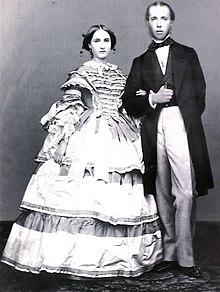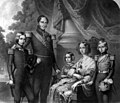Charlotte of Belgium
Template:Infobox Mexican Royalty
Charlotte of Belgium (Princess Marie Charlotte Amélie Augustine Victoire Clémentine Léopoldine of Belgium), (7 June, 1840–19 January, 1927) as Charlotte (or Carlota), Empress of Mexico was the consort of Emperor Maximilian I of Mexico, Archduke of Austria.
Princess of Belgium
The only daughter of Leopold I, King of the Belgians (1790–1865) by his second wife, Louise-Marie, Princess of France (1812–1850), Charlotte was born at the Royal Castle of Laeken in Laeken, Brussels, Belgium. She was named after her father's first wife, Princess Charlotte of Wales, who had died during childbirth. Charlotte had three brothers: Louis-Philippe, who died in infancy, Leopold, who on the death of their father became Leopold II of Belgium and Philippe, Count of Flanders. She was also a first cousin to both Queen Victoria of the United Kingdom and her husband, Prince Albert, as well as Ferdinand II of Portugal.
Her favorite grandparent Maria Amalia of the Two Sicilies, Queen of France, was the consort of Louis-Philippe of France, and a niece of Marie Antoinette. Maria Amalia was Charlotte's close confidante, and on her wedding day in 1857, she wore a bracelet with a miniature portrait of her. They regularly corresponded, especially later while Charlotte was in Mexico.
When Charlotte was ten years old, her mother, Louise-Marie, died of tuberculosis and Charlotte was entrusted to the Countess of Hulste, a close family friend. Although young, the princess had her own household; but for a few weeks out of the year, Charlotte stayed in Claremont with Maria Amalia and the rest of her mother's family in exile.
She belonged to the House of Saxe-Coburg and Gotha, which took its name from the tiny German duchy that was the homeland of her father, Belgium's first king.
Archduchess of Austria

On 27 July, 1857 in Brussels, Charlotte married her second cousin Archduke Maximilian of Austria (in fact they shared two of their great-grandparents in common: Ferdinand I of Two Sicilies and Marie Caroline of Austria), the idealistic younger brother of Emperor Franz Josef of Austria. In the Court of Vienna she was much prized by her mother-in-law, who saw in her the perfect example of a wife to an Austrian Archduke. Charlotte disliked Empress Elizabeth (also known as Sissi, Franz Josef's wife). It is said that the archduchess disliked the deep connection there was between the empress and Maximilian, who were confidantes and shared the same tastes for many things, especially because her sister-in-law was universally admired for her beauty and charms.
Charlotte spent several relatively happy years in Italy as Maximilian's wife while the archduke served as governor of the provinces of Lombardy and Venetia. Although Lombardy and Venetia were then under the rule of the Austrian Empire, neither Maximilian nor Charlotte held real power, and both were fatally eager for more challenging roles in life.
Family
Charlotte and Maximilian had no children, but in 1865 the imperial couple adopted Agustín de Iturbide y Green and Salvador de Iturbide y de Marzán – grandsons of Agustín de Iturbide y Arámburu, an earlier emperor of Mexico (r. 1822-23). They gave two-year-old Agustín the title of "His Highness, The Prince of Iturbide" —similar imperial titles were accorded to various members of the child's extended family—and intended to groom him as heir to the throne. The explosive events of 1867, however, dashed such hopes, and after he grew to adulthood, Agustín renounced all rights to the Mexican throne, served in the Mexican army, and eventually established himself as a professor at Georgetown University.
Rumors persist that, in 1866, Charlotte was having an affair with Belgian officer Colonel Alfred van der Smissens and that she gave birth to a son, Maxime Weygand, in Brussels on 21 January, 1867. Weygand refused to confirm or deny the persistent rumor and his parentage remains uncertain. Weygand was a French military commander in both World War I and II.1
Empress of Mexico
In the early 1860s, the ambitious Napoleon III initiated the French intervention in Mexico. France, eager to turn Mexico into a satellite state, searched for a suitable figurehead to serve as the nominal emperor of Mexico. Maximilian accepted the Mexican crown and the couple sailed for the New World. The imperial couple were crowned at the Catedral Metropolitana in 1864 and chose as their seat Mexico City, making their home in the neo-Gothic fantasy castle of Chapultepec. As Empress, Charlotte took the name of Carlota (Spanish for Charlotte). Carlota tried to take her imperial duties seriously, and even undertook a tour of the remote Yucatán frontier, visiting the ruins of Uxmal.

Only months after the coronation, however, Napoleon III began signaling his abandonment of Maximilian, and the French began to withdraw their troops from Mexico. This strategic pullback was a potentially fatal blow to the infant Mexican monarchy. The situation was exacerbated by a United States blockade that prevented French reinforcements from landing. In a desperate attempt to save her husband's throne, Charlotte returned to Europe, seeking assistance for her husband in Paris, Vienna, and finally in Rome from Pope Pius IX. Her efforts failed; she manifested symptoms of paranoia, suffered a profound cognitive and emotional collapse, and never returned to Mexico.
The empress dowager
President Benito Juarez of the Republic of Mexico oversaw the execution of Maximilian in 1867. (His last words were reportedly of his absent wife: "Poor Carlota!"[1]). The empire had collapsed after only three years. Carlota's mental state continued to be poor. Her brother Prince Philippe, Count of Flanders, had her examined by alienists, who pronounced her insane. She spent the rest of her life in seclusion, first at Miramar Castle near Trieste, Italy, and then at the Castle of Bouchout in Meise, Belgium. During World War I, her Belgian estate was surrounded by the occupying German army, but the estate itself was sacrosanct because Austria was one of Germany's chief allies and she was the widowed sister-in-law of the Austrian emperor.
As Charlotte's illness progressed, her paranoia faded. She remained deeply in love with her husband. After his death, she cherished all of the surviving possessions they had enjoyed in common. During the remainder of her life (1867-1927) she believed herself still to be the empress of the Mexicans. She further convinced herself that Maximilian was still alive and would soon return to her. It is said that she even slept with a small doll in her bed, whom she called "Max".[citation needed]
Charlotte died at the Bouchout Castle, in Meise, Belgium, on 19 January, 1927.
Ancestry
Gallery
-
Empress Carlota of Mexico
-
The first Belgian Royal Family, King Leopold I, Queen Louise-Marie, Crown Prince Leopold, Prince Philippe, and Princess Marie-Charlotte
In popular culture
Bette Davis portrayed the tragic empress in the 1939 film Juarez, directed by William Dieterle. So did Medea de Novara in the four Mexican productions directed by Miguel Contreras Torres, Juárez y Maximiliano (1933), La Paloma (1937), The Mad Empress (1940) and Caballería del Imperio (1942).
Charlotte is also referenced in the first season of The Dick Van Dyke Show in an episode titled "Empress Carlotta's Necklace."
Literature
- Prince Michael of Greece; The Empress of Farewells - The Story of Charlotte, Empress of Mexico, New York 1998.
- del Paso,Fernando: Noticias del Imperio. México 1987
- Bibesco, Princesse Marthe: Charlotte et Maximilien. París 1962.
- Castelot, André: Maximiliano y Carlota. La Tragedia de la Ambición. México 1985.
- Corti, Conte Egon Caesar: Maximilian und Charlotte von Mexiko. Nach dem bisher unveröffentlichten Geheimarchive des Kaisers Maximilian und sonstigen unbekannten Quellen. 2 Vols. Zurich, Leipzig, Viena 1924.
- Corti, Conte Egon Caesar: Maximilian von Mexiko. Die Tragödie eines Kaisers. Francfort del Meno 1953.
- Desternes, Suzanne; Chandet, Henriette: Maximilien et Charlotte. París 1964.
- Gómez Tepexicuapan, Amparo: “Carlota en México.” En: Igler, Susanne; Spiller, Roland (eds.): Más nuevas del imperio. Estudios interdisciplinarios acerca de Carlota de México. Francfort del Meno 2001. (=Erlanger Lateinamerika-Studien. 45). p. 27-40.
- Miguel de Grecia: La Emperatriz del Adiós. El trágico destino del emperador Maximiliano y su mujer Carlota. Barcelona 2000.
- Harding, Bertita: Phantom Crown. The story of Maximilian and Carlota of Mexico. 3a edición. México 1967 [1935].
- Haslip, Joan: The Crown of Mexico: Maximilian and his Empress Carlota. 2a edición. Nueva York 1972.
- Hyde, Montgomery H.: Mexican Empire. The history of Maximilian and Carlota of Mexico. Londres 1946.
- Igler, Susanne: Carlota de México. México 2002. (=Grandes Protagonistas de la Historia Mexicana) [segunda edición: 2006].
- Igler, Susanne: De la intrusa infame a la loca del castillo: Carlota de México en la literatura de su 'patria adoptiva'. Frankfurt: Peter Lang 2007 (Studien und Dokumente zur Geschichte der Romanischen Literaturen, 58).
- Kerckvoorde, Mia: Charlotte. La passion et la fatalité. París 1981.
- Maria y Campos, Armando: Carlota de Bélgica. La infortunada Emperatriz de México. México 1944.
- Praviel, Armand: La vida trágica de la emperatriz Carlota. Buenos Aires 1937.
Notes
- ^ Brewer, E. Cobham. Dictionary of Phrase & Fable. Dying Sayings at www.bartleby.com
External links
- Royal House of Belgium
- Imperial House of Austria
- Imperial House of Mexico
- Biography of Charlotte of Belgium (1840-1927)
- Imperial House of Mexico
- Find-A-Grave profile for Carlotta Empress of Mexico
- 1923 Newspaper Interview with one of Carlota's Ladies (in Spanish)
1 *The Crown of Mexico by Joan Haslip, ISBN 0-03-086572-7


